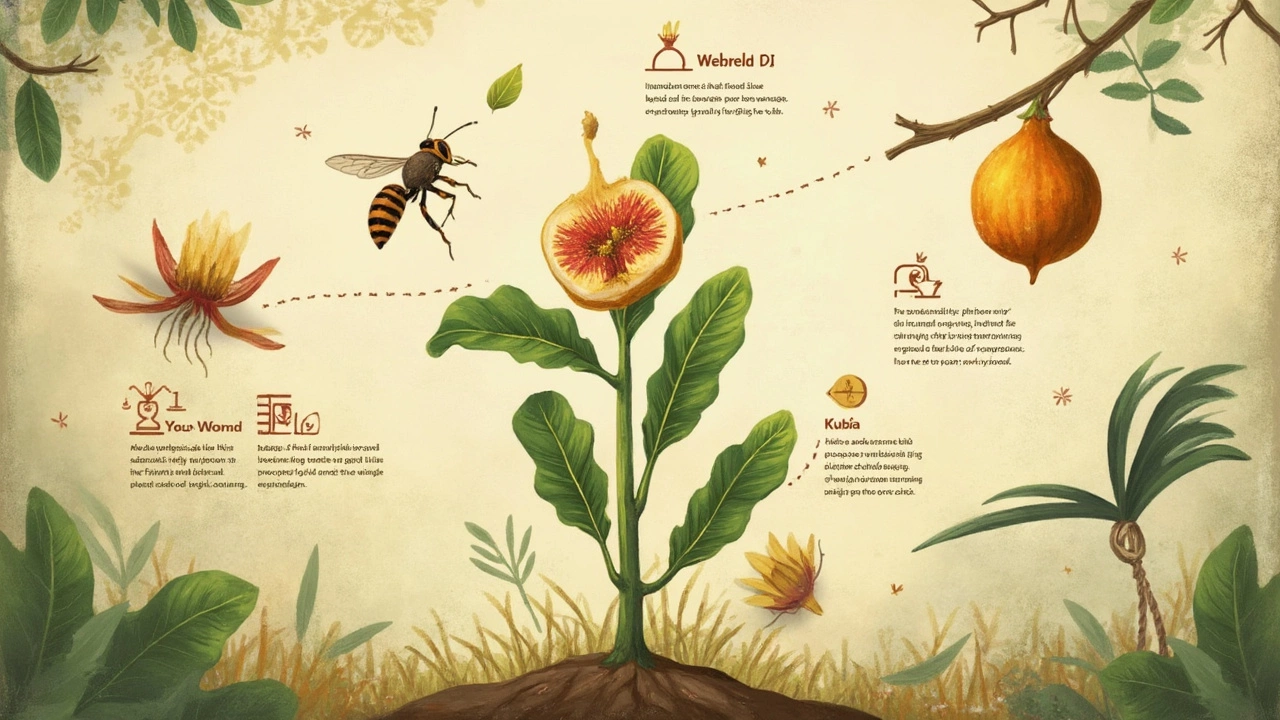So, you’re eyeing that gorgeous fig tart at the bakery and wondering: can vegans really eat figs? Here’s the twist—figs may look innocent, but there’s a reason they spark debate in the vegan world. It doesn’t matter if you’re baking a dessert or grabbing a snack bar with figs inside—behind those sweet bites is a story you might not expect.
The drama isn’t about the fruit itself but how figs grow in nature. It involves tiny insects, and not everyone’s comfortable with the details. Some vegans decide figs are off the table, while others feel fine about digging in. Understanding why makes it a lot easier to decide what works for you, especially when you want your desserts to line up with your ethics.
- Why Figs Spark Debate Among Vegans
- How Figs Are Pollinated
- What Happens to the Wasp?
- Choosing Vegan Desserts with Figs
- Are There Truly Vegan Figs?
Why Figs Spark Debate Among Vegans
Here’s where things get tricky with figs: even though they look like a regular fruit, their pollination process involves wasps. This is where some vegans hit pause. Most figs grown for commercial use rely on fig wasps to reproduce. These tiny insects crawl into the fig to lay their eggs, and sometimes die inside the fruit during the process. For anyone following a vegan lifestyle—which often means avoiding animal death or exploitation—this bugs them (pun intended).
Still, not all vegans see it as a hard no. Some figure that since the wasp’s life cycle is just how nature works, and the process isn’t caused by humans directly, eating figs isn’t the same as supporting animal farming. Others argue that if an animal dies because of how a food is produced, that food can’t be called vegan. That’s the crux of the debate, and it’s why you see people on both sides.
People often want concrete details about these so-called dead wasps in figs. Turns out, commercial varieties like the common Mission and Kadota figs are actually pollinated without wasps, thanks to smart farming techniques. But certain specialty figs—like the Calimyrna—do depend on wasps for pollination. Here’s a quick breakdown:
| Fig Variety | Pollination Method | Wasp Involved? |
|---|---|---|
| Mission | Self-pollinating | No |
| Kadota | Self-pollinating | No |
| Calimyrna | Caprification (Wasp pollinated) | Yes |
| Smyrna | Caprification (Wasp pollinated) | Yes |
It all comes down to personal choice, since there’s no single “right” answer among vegans. If eating only vegan desserts is important to you, learning a bit about where your figs come from (and how they grow) will help you decide if they make the cut—or if you’ll pass.
How Figs Are Pollinated
It’s not the same as an apple tree getting a visit from a bee. Instead, figs and a specific kind of wasp have a whole secret partnership. Here’s how it works: fig trees make flowers, but they’re hidden inside what looks like the fruit. These tiny flowers can’t get pollinated by wind or regular insects.
Enter the fig wasp. Female wasps crawl into the fig through a tiny opening called the ostiole. It’s a tight squeeze—she actually loses her wings and antennas on the way in. Once she’s inside, she lays her eggs and, at the same time, drops the pollen she brought from another fig.
After eggs are laid, the wasp’s life pretty much ends inside the fig. While this sounds wild, remember: not every wasp makes it out again, and the process is how wild figs get pollinated and develop seeds. It’s a one-of-a-kind system—not something you find with most common fruit.
Without this teamwork, you wouldn’t get the vegan fig desserts you see in bakeries. But this relationship, where an insect gives its life to grow a fig, is why so many people on a vegan diet pause before eating figs.

What Happens to the Wasp?
Here’s where things get weird—and a bit squirmy. Some types of figs need a specific wasp to pollinate them. The wasp squeezes inside the fig to lay her eggs. On the way, she pollinates the fig. After that, her journey ends inside the fruit. She actually can’t get out, and that’s why this freaks out a lot of vegans.
Now, you’re probably wondering: Do we eat dead wasps when we eat figs? Here’s the thing—those wasps don’t stick around. Figs have special enzymes that break down and digest the wasp’s body. By the time the fig is ripe, the wasp is completely gone. You don’t see anything. You don’t taste anything. For most people, what’s left isn’t “wasp” anymore. It’s just part of the fig, like any other plant matter.
- Caprifigs (wild male figs) usually host the wasp eggs. They’re rarely eaten by humans.
- Edible figs (female figs) sometimes trap a single wasp, but again, her body breaks down quickly.
- Not all figs require wasps. Many commercial figs, like those from California, are grown with self-pollinating varieties. No wasps are involved at all in these cases.
Check out this quick comparison between types of figs in the table below—because not all figs come with wasp drama.
| Fig Type | Needs Wasp? | Wasp Remains Inside? | Common in Stores? |
|---|---|---|---|
| Bursting Figs (Smyrna) | Yes | Enzymes dissolve wasp | Sometimes (imported) |
| Common Fig (Black Mission, Kadota, Brown Turkey) | No | No wasp inside | Very common |
| Caprifig | Yes | Wasp lays eggs, not eaten | Rarely sold |
So, when you bite into a vegan fig dessert, you’re not crunching on insects. But for some vegan eaters, even the idea of an animal dying as part of farming doesn’t feel right. Others are fine with it, since no animal product is actually present. As always, it really depends on where you draw your line.
Choosing Vegan Desserts with Figs
Shopping for vegan desserts can get confusing when you run into figs on ingredient lists. It all comes down to how you feel about the fig-wasp story. Some vegans are totally comfortable eating figs, while others want to avoid them, just in case. If you’ve decided you want to keep your desserts as vegan as possible, there are a few things to think about before you pick up that fig bar or bake another fig tart.
First, not all figs are pollinated the same way. Common varieties sold in the US and UK, like Brown Turkey and Black Mission, usually don’t need wasps anymore. Farmers use self-pollinating types or even force pollination by hand. Smyrna figs, which are mostly grown in California for dried fig snacks, still rely on pollination by tiny female wasps, though. If you want to be mindful, it’s worth checking which type of fig you’re eating.
Here’s a quick cheat sheet for the most common figs found in stores and how they’re pollinated:
| Fig Variety | Pollination Method | Common in Vegan Desserts? |
|---|---|---|
| Brown Turkey | Self-pollinating | Yes |
| Black Mission | Self-pollinating | Yes |
| Kadota | Self-pollinating | Sometimes |
| Smyrna | Requires wasps | Often in dried products |
So, if you’re baking at home, reach for varieties that use self-pollination. When reading labels on store-bought desserts or fig bars, you’ll only sometimes see what kind of figs were used. If you want to be 100% sure, look for brands that mention specific types, or even contact them to ask—some smaller brands love to explain their process, especially if their products are vegan-friendly.
- If you’re eating out or buying bakery items, ask the staff if they know which vegan fig variety they use. It’s not rude—people ask about ingredients all the time!
- Want a no-worry dessert? Swap figs for other fruits like dates or apricots in your recipes. They have a similar sweetness and texture.
A little label reading and ingredient checking goes a long way. With just a tiny bit of effort, you can enjoy your fruity desserts the vegan way—and even help friends understand the fig conundrum the next time they ask.

Are There Truly Vegan Figs?
This might surprise you, but not all figs end up with a wasp inside. It depends a lot on the type of fig and how it's grown. In fact, the whole wasp drama is mostly about certain varieties—like Smyrna or Calimyrna figs—that need pollination from a specific wasp to produce fruit. Most of the figs you'll find in regular grocery stores, especially in the US and Europe, are the "common fig" types. These don't need wasps at all—they develop through something called parthenocarpy, which is just a fancy word for fruit growing without pollination.
If you really want to avoid any chance of insect involvement, look for varieties like Brown Turkey, Kadota, and Mission figs. They're super popular and are grown without wasps, so they're widely seen as safe for strict vegan diets.
- If you're shopping for figs, ask your grocer what kind they carry. Most likely, it's a common type that's wasp-free.
- When in doubt, check with the producer or look at the packaging—sometimes, organic or boutique brands mention how their figs are pollinated.
- For fig spreads, jams, and vegan desserts, commercial brands almost always use common figs since they're easier and cheaper to grow and harvest.
Check out this quick comparison so you know what to look for:
| Fig Type | Needs Wasp for Pollination? | Common in Stores? |
|---|---|---|
| Mission | No | Yes |
| Brown Turkey | No | Yes |
| Kadota | No | Yes |
| Smyrna | Yes | Sometimes |
| Calimyrna | Yes | Yes (Some regions) |
If you’re sticking to a *strong>vegan* lifestyle and want easy options, pick figs labeled as Brown Turkey, Kadota, or Mission. These are everywhere and you won’t have to stress about hidden animal stuff. So, yes, truly vegan figs do exist—you just need to know where to look.